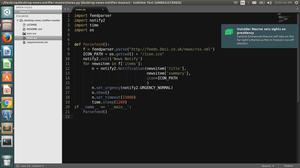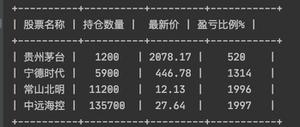举例介绍Python中的25个隐藏特性
注:这里忽略了生成器,装饰器,交换变量等熟知技巧
1. 函数参数unpack
老生常谈的了:
def foo(x, y):
print x, y
alist = [1, 2]
adict = {'x': 1, 'y': 2}
foo(*alist) # 1, 2
foo(**adict) # 1, 2
2. 链式比较操作符
>>> x = 3
>>> 1 < x < 5
True
>>> 4 > x >=3
True
3. 注意函数的默认参数
>>> def foo(x=[]):
... x.append(1)
... print x
...
>>> foo()
[1]
>>> foo()
[1, 1]
更安全的做法:
>>> def foo(x=None):
... if x is None:
... x = []
... x.append(1)
... print x
...
>>> foo()
[1]
>>> foo()
[1]
>>>
4. 字典有个get()方法
dct.get(key[,default_value]), 当字典dct中找不到key时,get就会返回default_value
sum[value] = sum.get(value, 0) + 1
5. 带关键字的格式化
>>> print "Hello %(name)s !" % {'name': 'James'}
Hello James !
>>> print "I am years %(age)i years old" % {'age': 18}
I am years 18 years old
更新些的格式化:
>>> print "Hello {name} !".format(name="James")
Hello James !
快有些模板引擎的味道了:)
6. for…else 语法
>>> for i in (1, 3, 5):
... if i % 2 == 0:
... break
... else:
... print "var i is always an odd"
...
var i is always an odd
>>>
else语句块会在循环结束后执行,除非在循环块中执行break
7. dict 的特殊方法__missing__
Python 2.5之后引入的。当查找不到key的时候,会执行这个方法。
>>> class Dict(dict):
... def __missing__(self, key):
... self[key] = []
... return self[key]
...
>>> dct = Dict()
>>> dct["foo"].append(1)
>>> dct["foo"].append(2)
>>> dct["foo"]
[1, 2]
这很像collections.defaultdict不是吗?
>>> from collections import defaultdict
>>> dct = defaultdict(list)
>>> dct["foo"]
[]
>>> dct["bar"].append("Hello")
>>> dct
defaultdict(<type 'list'>, {'foo': [], 'bar': ['Hello']})
8. 切片操作的步长参数
还能用步长-1来反转链表:
9.另一种字符串连接
>>> Name = "Wang" "Hong"
>>> Name
'WangHong'
连接多行:
>>> Name = "Wang" \
... "Hong"
>>> Name
'WangHong'
10. Python解释器中的”_”
>>> range(4)
[0, 1, 2, 3]
>>> _
[0, 1, 2, 3]
_即Python解释器上一次返回的值
11. Python 描述器
Python描述器是Python 中很魔幻的东西,方法等都是描述器。不再举例
12. Zen
import this
13. 嵌套列表推导式
>>> [(i, j) for i in range(3) for j in range(i)]
[(1, 0), (2, 0), (2, 1)]
14. try/except/else
try:
put_4000000000_volts_through_it(parrot)
except Voom:
print "'E's pining!"
else:
print "This parrot is no more!"
finally:
end_sketch()
15. print 重定向输出到文件
>>> print >> open("somefile", "w+"), "Hello World"
注意打开的模式:"w+"而不能"w", 当然"a"是可以的
16. 省略号
在Python3中你可以直接使用省略号这个文法:
Python 3.2 (r32:88445, Oct 20 2012, 14:09:50)
[GCC 4.5.2] on linux2
Type "help", "copyright", "credits" or "license" for more information.
>>> ...
Ellipsis
Python2 中呢?
>>> class C(object):
... def __getitem__(self, item):
... return item
...
>>> C()[1:2, ..., 3]
(slice(1, 2, None), Ellipsis, 3)
>>>
17. Python3中的元组unpack
真的但愿Python2也这样:
>>> a, b, *rest = range(10)
>>> a
0
>>> b
1
>>> rest
[2, 3, 4, 5, 6, 7, 8, 9]
>>>
当然也可以取出最后一个:
>>> first, second, *rest, last = range(10)
>>> first
0
>>> second
1
>>> last
9
>>> rest
[2, 3, 4, 5, 6, 7, 8]
18. pow()还有第三个参数
我们都知道内置函数pow,pow(x,y)即x**y
但是它还可以有第三个参数:
>>> pow(4, 2, 2)
0
>>> pow(4, 2, 3)
1
其实第三个参数是来求模的:pow(x,y,z)?==?(x**y)?%z
注意,内置的pow和math.pow并不是一个函数,后者只接受2个参数
19. enumerate还有第二个参数
enumerate很赞,可以给我们索引和序列值的对, 但是它还有第二个参数:
>>> lst = ["a", "b", "c"]
>>> list(enumerate(lst, 1))
[(1, 'a'), (2, 'b'), (3, 'c')]
这个参数用来: 指明索引的起始值
20. 显式的声明一个集合
新建一个集合,我们会:
>>> set([1,2,3])
在Python 2.7 之后可以这么写了:
>>> {1,2,3}
set([1, 2, 3])
21. 用切片来删除序列的某一段
>>> a = [1, 2, 3, 4, 5, 6, 7]
>>> a[1:4] = []
>>> a
[1, 5, 6, 7]
当然用dela[1:4]也是可以的
去除偶数项(偶数索引的):
>>> a = [0, 1, 2, 3, 4, 5, 6, 7]
>>> del a[::2]
>>> a
[1, 3, 5, 7]
22. isinstance可以接收一个元组
这个真的鲜为人知, 我们可以用isinstance(x,(float,int))来判断x是不是数:
>>> isinstance(1, (float, int))
True
>>> isinstance(1.3, (float, int))
True
>>> isinstance("1.3", (float, int))
False
那么对于第三个测试,你把str加入元组就可以看到这是怎么回事了:
>>> isinstance("1.3", (float, int, str))
True
也就是那个元组里面是或的关系,只要是其中一个的实例就返回True
23. 字典里的无限递归
>>> a, b = {}, {}
>>> a['b'] = b
>>> b['a'] = a
>>> a
{'b': {'a': {...}}}
当然你可以制作一个链表中的无限循环:
>>> a, b = [], []
>>> a.append(b)
>>> b.append(a)
>>> a
[[[...]]]
真心不知道有什么用,不过蛮好玩的不是吗
24. Python可以认识Unicode中的数字
所以说,Python很赞:
>>> int(u'1234')
1234
不只是ASCII字符串的可以认出来,连Unicode的也可以。
25. 不能访问到的属性
回答这个答案的人太坏了:)
>>> class O(object):pass
...
>>> o = O()
>>> setattr(o, "can't touch this", 123)
>>> o.can't touch this
File "<stdin>", line 1
o.can't touch this
^
SyntaxError: EOL while scanning string literal
>>>
File "<stdin>", line 1
o.can't touch this
^
SyntaxError: EOL while scanning string literal
不过,能用setattr设置属性,就可以用getattr取出
以上是 举例介绍Python中的25个隐藏特性 的全部内容, 来源链接: utcz.com/z/325931.html




